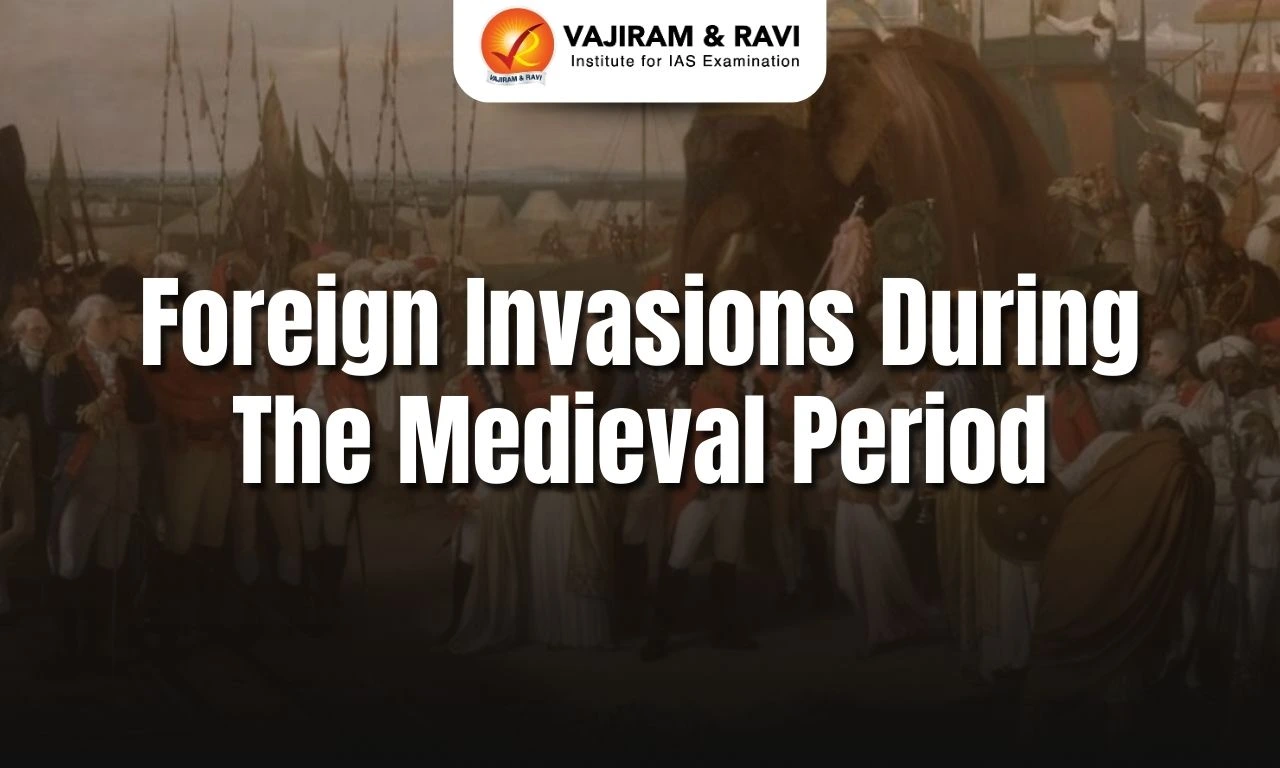Causes of Foreign Invasions
The reasons for foreign invasions can be summarised in various factors.
- Economic prosperity: The wealth and prosperity of India were one of the prime factors which lured foreigners to invade India.
- India possessed great agricultural potential compared to invading kingdoms.
- Political Weakness in India: It was another cause of the defeat of the Indians.
- During the medieval period, India was politically divided into many states which constantly fought against each other.
- After emperor Ashoka, India could not be united under one rule.
- Weak Social System: The prevalent social condition of medieval times also weakened India.
- The caste system, the practice of untouchability, and the inequitable position of women contributed to the main weaknesses of Indian society.
India
The rise of Islam in Arabia gave rise to a new political system. The process of expansion, which had started after the capture of Mecca by the prophet Muhammad, continued after his death.
- The Arabs invaded India in AD 712 from the North-West region.
- Muhammad Bin Qasim, a general of the Umayyad caliphate, led this invasion.
- The invasion of India was part of the policy of Arab expansion during this period.
- By the 8th Century AD, the Arab expansion had acquired a core position from Spain to India, connecting the trade of the Mediterranean and the Indian Ocean.
- The wealth of India attracted Arabs.
The Conquest of Sindh
The Arab merchants had active trade relations with their Indian and south-east Asian counterparts. They were known for the sea routes to the western coast of India.
- Reason for invasion: It was to avenge the plunder of Arab Ships by pirates of Debol (modern Karachi).
- Muhammad Bin Qasim: He besieged Debol in 712 AD, marched across the Indus and killed the King of Sindh, who refused to punish the pirates.
- Subsequently, all the neighbouring towns of Nirun, Rewar, Brahmanabad, Alor and Multan were also captured.
- Impact of Conquest: The economic life of Sindh got disturbed as a result of the campaigns of Qasim.
- A large number of people and merchants had fled from Sindh.
- Qasim had conquered the major portion of Sindh up to the lower Punjab.
- His rule lasted only for two years. However, many Arabs settled down in Sindh and established relations with the local population.
Turkish Invasion of India
The successful invasion of India by Muslim Turks such as Mahmud Ghazni and Muhammad Ghori in the 11th and 12th centuries, respectively, can be considered as the culmination of the background set by Sindh's conquest in the 8th century.
Mahmud Ghazni
In all, Mahmud Ghazni invaded India seventeen times during AD 1000–1026. Mahmud Ghazni was the Son of Sabuktigin, the founder of the Ghazni dynasty & Turkish slave commander.
- First encounter: Mahmud Ghazni first encountered the Hindushai ruler, Jaipal, in AD 1001.
- Subsequent attacks: In the years AD 1004–06, Mahmud Ghazni attacked the rulers of Multan.
- Soon Punjab also passed into the hands of the Ghaznavids.
- Between AD 1014–1019, Mahmud enriched his treasury by looting the temples of Nagarkot, Thanesar, Mathura and Kannauj.
- The attack against Nagarkot in AD 1008 has been described as his first great triumph.
- Somnath attack: The attack on the Somnath temple in Saurashtra in AD 1025 was Mahmud’s most ambitious Indian campaign.
- Mahmud captured the city after the grim struggle in which more than 50,000 defenders lost their lives.
- Mahmud left Somnath after a fortnight when he came to know that the Gujarat king Bhima-I had completed preparations to confront him.
- Ghazni’s ambitions: His raids into India were only to acquire the famous wealth of India. This wealth would help him to consolidate his vast rule in Central Asia.
- He did not wish to establish an empire in India.
- Weak Indian defence exposure: However, his invasions exposed the weak defence of Indian kingdoms.
- They also opened the possibility of attacks in future by the Turks.
Muhammad Ghori
In AD 1173, Shahabuddin Muhammad, also called Muhammad of Ghori, ascended the throne of Ghazni. The Ghoris were not strong enough to meet the growing power and strength of the Khwarizmi Empire of Central Asia. This forced Ghori to turn towards India to fulfil his expansionist ambitions.
- Initial campaigns: Ghori marched against Multan and freed it from its ruler in AD 1175.
- In the same campaign, he captured Uchch from the Bhatti Rajputs.
- Three years later, in AD 1178, he again marched to conquer Gujarat, but the Chalukya ruler of Gujarat, Bhima II, defeated him at the battle of Anhilwara.
- Punjab conquest: Ghori launched a campaign against the Ghaznavid possessions in Punjab.
- As a result, Peshawar was conquered in AD 1179–80 and Lahore in AD 1186.
- The fort of Sialkot and Debol were captured next.
- Thus by AD 1190, having secured Multan, Sind and Punjab, Muhammad Ghori had paved the way for a further thrust into the Gangetic Doab.
- The First Battle of Tarain (AD 1191): Ghori’s possession of Punjab and his attempt to advance into the Gangetic Doab brought him into direct conflict with the Rajput ruler Prithivaraja Chauhan.
- The conflict started with the claims of Bhatinda.
- Ghori’s army was routed, and he narrowly escaped death.
- Prithviraj conquered Bhatinda, but he made no effort to garrison it effectively.
- This gave Ghori an opportunity to re-assemble his forces and make preparations for another advance into India.
- The Second Battle of Tarain (AD 1192): This battle is regarded as one of the turning points in Indian History.
- The Indian forces were more in number, but Turkish forces were well organised with swift-moving cavalry.
- With modern cavalry techniques, the Turkish army defeated Indian forces.
- A large number of Indian soldiers were killed. Prithviraj tried to escape but was captured near Sarsuti.
- The Turkish army captured the fortresses of Hansi, Sarsuti and Samana. Then they moved forward, running over Delhi and Ajmer.
- After Tarain, Ghori returned to Ghazni, leaving the affairs of India in the hand of his trusted slave general Qutbuddin Aibak.
- Battle of Chandwar: In AD 1194, Muhammad Ghori again returned to India. He crossed Yamuna and moved towards Kanauj.
- He gave a crushing defeat to Jai Chand at Chandwar near Kannauj.
- Thus the battle of Tarain and Chandwar laid the foundations of Turkish rule in Northern India.
Mongol Invasion of India
Mongols invaded India from 1221 to 1327. The Mongols made Kashmir their vassal state. However, the campaigns against the Delhi Sultanate proved unsuccessful despite constant Mongol incursions.
- Genghis Khan invasion: During his reign, he made several raids into the Indian subcontinent while chasing down Jalal-ud-din, the last scion of the Khwarezmian Empire.
- He reached all the way to the outskirts of Lahore near the Indus River before defeating him in 1221.
- After his death in 1227, his son Ogedei Khan became the Great Khan.
- In 1235, Mongols attacked Kashmir. It remained under the Mongols for several years since then.
- Invasions against Delhi Sultanate: In the 1280s, Duwa Khan made several attacks on Sindh, Balochistan, Lahore, and Multan.
- Alarmed by invasions, the Sultanate, under the reign of Balban, prepared his army.
- As a result, large-scale attacks ceased, and Mongols could not cross the Indus River. It was followed by future rulers.
- In 1292, the Chagatai Khanate raided Punjab during the reign of Jalaluddin Khilji and faced severe defeat.
- Chagatai faced various losses by the Khiljis between 1296 to 1297.
- Several major attacks happened under Alauddin Khalji.
- In 1297, Chagatai Noyan Kadar was defeated in the battle of Jaran-Manjur.
- In 1298-99, Mongols invaded Sindh and captured the Sivistan fort. However, Zafar Khan, the military general of Alauddin, defeated the forces at the siege of Sehwan.
- The most significant defeat of the Mongols happened in 1299 in the Battle of Killi near Delhi. The Chagatai Mongols had to face a big retreat.
- Alauddin Khalji defeated the Mongols at the Battle of Amroha and Ravi in 1305 and 1306, respectively.
- In 1306, with the death of Duwa, the spate of invasions ended
- Alarmed by invasions, the Sultanate, under the reign of Balban, prepared his army.
Later Mongol Raids
- Major Mongol invasions again happened during the reign of the Tughlaq dynasty in 1327.
- Chagatai ruler Tarmashirin attacked and besieged Delhi, and Muhammad bin Tughlaq had to pay a huge ransom to free Delhi from him.
- After Tarmashirin, no major attacks materialised by the Mongols against India.
Timurid Invasion of India
Timur invaded India in 1398, attacking the Delhi Sultanate ruled by Mahmud Shah Tughluq.
- After crossing the Indus, he sacked Tulamba and massacred its inhabitants. He captured Multan afterwards.
- His invasion was unopposed, as most of the Indian nobility surrendered without a fight.
- However, he did encounter resistance from the united army of Rajputs and Muslims at Bhatner under the command of the Rajput king Dulachand.
- Dulachand initially opposed Timur, but when hard-pressed, he considered surrender.
Capture of Delhi (1398)
Timur had capitalised on the disruption in the forces of Mahmud Shah Tughluq, securing an easy victory.
- It was one of Timur’s largest and most devastating victories as, at that time, Delhi was one of the richest cities in the world.
- The city of Delhi was sacked and reduced to ruins, with the population enslaved.
- After the fall of the city, uprisings by its citizens against the Turkic Mongols began to occur, causing a bloody retaliatory massacre within the city walls.
Invasion by Babur
The unstable political situation in India after Sikandar Lodi’s death convinced Babur of political discontentment and disorder in the Lodi Empire.
- Invitation to invade: There was a conflict between Afghan Chieftan Daulat Khan and the Rajput king of Mewar Rana Sanga with Ibrahim Lodi.
- Both of them sent word to Babur to invade India.
- Battle of Panipat (1526): Before this battle, Babur was successful in capturing Bhira (1519–1520), Sialkot (1520) and Lahore (1524) in Punjab.
- Babur’s Soldiers were fewer in number, but the organisation of his army was superior.
- Ibrahim Lodi was defeated in the battle of Panipat.
- Later conquest: Babur defeated the joint army of Rajput kingdoms led by Rana Sanga rulers in the battle of Khanwa near Fatehpur Sikri.
- Mughal rule: The success against the Afghans and Rajputs at Panipat and Khanwa was very significant in establishing Mughal rule in India.
Last updated on November, 2025
→ Check out the latest UPSC Syllabus 2026 here.
→ Join Vajiram & Ravi’s Interview Guidance Programme for expert help to crack your final UPSC stage.
→ UPSC Mains Result 2025 is now out.
→ UPSC Notification 2026 is scheduled to be released on January 14, 2026.
→ UPSC Calendar 2026 is released on 15th May, 2025.
→ The UPSC Vacancy 2025 were released 1129, out of which 979 were for UPSC CSE and remaining 150 are for UPSC IFoS.
→ UPSC Prelims 2026 will be conducted on 24th May, 2026 & UPSC Mains 2026 will be conducted on 21st August 2026.
→ The UPSC Selection Process is of 3 stages-Prelims, Mains and Interview.
→ UPSC Result 2024 is released with latest UPSC Marksheet 2024. Check Now!
→ UPSC Prelims Result 2025 is out now for the CSE held on 25 May 2025.
→ UPSC Toppers List 2024 is released now. Shakti Dubey is UPSC AIR 1 2024 Topper.
→ UPSC Prelims Question Paper 2025 and Unofficial Prelims Answer Key 2025 are available now.
→ UPSC Mains Question Paper 2025 is out for Essay, GS 1, 2, 3 & GS 4.
→ UPSC Mains Indian Language Question Paper 2025 is now out.
→ UPSC Mains Optional Question Paper 2025 is now out.
→ Also check Best IAS Coaching in Delhi
Foreign Invasions During the Medieval Period FAQs
Q1. What is the literary source depicting the history of Sindh?+
Q2. What was the area of Arab expansion the world over?+

















